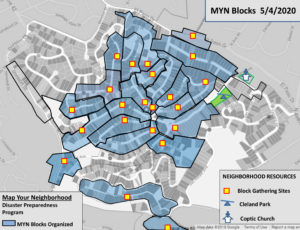In a disaster, your neighbors are your closest source of help. 911 First Responders may not be available for hours or days. Knowing your neighbors is one of the best ways to prepare for disaster.
Map Your Neighborhood (MYN) connects individual preparedness with preparedness on your block. Know who your neighbors are, who might need special assistance, and who might have special skills or equipment to help your neighbors in a disaster. When the emergency responders are overwhelmed, we will only have each other to rely on.
The 9-Step program is easy and covers what to do both at home and then on your block in the first 60 minutes after disaster strikes. Practicing makes it even easier.
The “Map Your Neighborhood” program was developed by LuAn Johnson, PhD of Prep Connect, Inc. It is endorsed and promoted by the American Red Cross. The program is in use throughout the US and was rolled out as the key tool of the “Ready Your LA Neighborhood” program. Map Your Neighborhood is also being integrated into the Los Angeles CERT Battalion 2 Master Plan. MYN is designed to bridge Community Emergency Response Team training (CERT) and individual preparedness.
MYN is implemented through an interactive meeting with 10-20 neighbors in one of their homes (or can be set up as a virtual meeting). A 9-step program is clearly laid out through informational videos that are watched and paused to develop simple maps and lists on the spot.
Everyone leaves with a custom booklet to keep under the bed for emergencies. The entire process takes only about 2 1/2 hours and participants leave both more prepared and better knowing their neighbors.
The package of 11 videos, featuring a neighborhood in Tigard, Oregon, are available on YouTube and on this page. Here is the introduction to give you the idea:
What are the 9 Steps?
Step 1 – Take care of your loved ones
Step 2 – Dress for Safety – Protect your head, hands and feet
Step 3 – Check the Natural Gas and Propane and shut-off if you smell, hear, or see evidence of leak
Step 4 – Shut off Water to prevent contamination from possible broken pipes elsewhere
Step 5 – Post OK / HELP sign
Step 6 – Place a Fire extinguisher on the curb visible to neighbors
Step 7 – Go to the Neighborhood Gathering Site
Step 8 – Form Teams to listen to emergency radios and check on neighbors
Step 9 – Return to the Gathering Site and report findings
Links to Individual Videos
01 – Introduction – 3:50
02 – Assumptions and Boundaries – 5:30
03 – 9 Steps Immediately Following Disaster – 25:03
04 – Identify Neighborhood Gathering Site – 2:33
05 – Identify Neighborhood Care Center – 3:47
06 – Neighborhood Skills and Equipment Inventory – 1:26
07 – Neighborhood Map – 2:06
08 – Contact List – 1:55
09 – Review Steps 1 – 7 – 2:38
10 – Steps 8 and 9 – 4:14
11 – Next Steps – 1:55
Host your own MYN meeting
If you’d like to host a Map Your Neighborhood workshop for your block, we can help you organize the meeting. You can plan to lead the meeting yourself (see the MYN Facilitator Training Video) or we can arrange to lead it for you. Send us an email to find out more.
I was surprised by how many little things I could do to be more prepared for my family and neighbors in case of a disaster. This workshop is invaluable and fun. Don’t miss this great opportunity. – Oneonta Drive neighbor
Links:
MYN-Discussion-Guide – from Washington State EMD (pdf)
Facilitator Training Video – Washington State EMD (YouTube)


